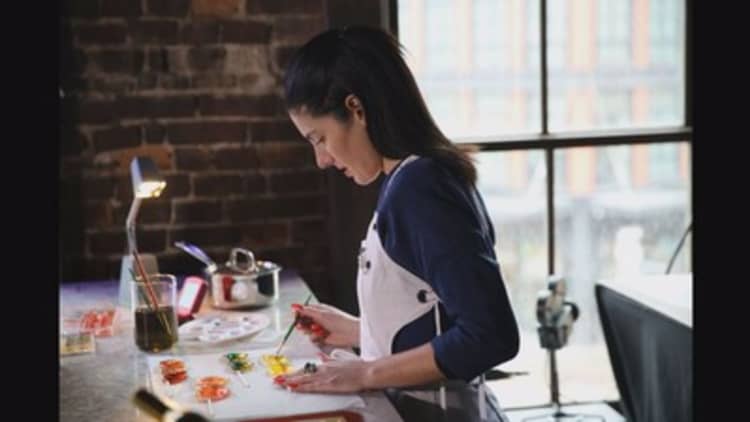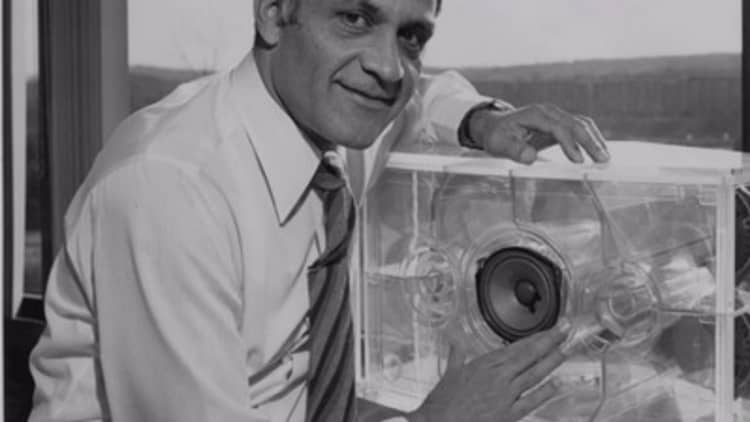You could say Bose Corp. owes its massive success in high-end audio to a serious case of buyer's remorse.
The company is one of the leading brands in audio and has been making speakers, headphones and audio equipment based on deep research into acoustics for just over a half a century. In the 1960s, the company devised an entirely new way of designing speakers. Later, it introduced the world's first commercial noise-canceling headphones, and it became the first company to design bespoke audio systems for cars.
Bose headphones are worn today by professional pilots and have been worn by space shuttle astronauts. Its car audio systems have been factory-installed in luxury brands such as Maserati and Maybach. And it still sells updated versions of its first product, the Bose 901 speaker.
Founder Amar Bose didn't set out to sell speaker systems and headphones. He began his career as an academic engineer at MIT in the late 1950s, licensing power conversion and amplification technology to the U.S. military and government agencies such as NASA.
Bose, who died in 2013 at age 83, had been interested in electronics and audio from an early age. At 10, he had gone on a Boy Scout trip for which someone had brought along a hobby radio communication kit. They drove a couple of antennae into the dirt and started talking to each other. Bose was hooked.
By 13, he was fixing radios in his parents' basement. The hobby became a business and helped support the family when his Indian-immigrant father's import business was shut down by a shipping ban during World War II.
Upon earning his Ph.D. from MIT, he gave himself a present: a high-end audio system.
"He did what an engineer, especially what a young engineer would do often in a situation like that," said Ken Jacob, chief brand officer at Bose. Jacob was one of Bose's students at MIT, where Bose taught through most of his career, before joining the company. "He analyzed all of the specifications for the available loudspeakers, thinking that if he did a rigorous analysis of the specifications, he could pick the best one."
After he made his choice, he took the set home and set it up.
But the speakers didn't sound right. Bose knew how they should sound. His parents had done for Bose what many loving American parents do for their children: they made him take violin lessons as a child. Though he wasn't destined for the stage, the violin gave him an ear for music.
All the time he had spent carefully comparing specs had still left him with an expensive disappointment.
So he began researching acoustics in his spare time. He and his fellow researchers spent their days working on their government contracts, and their nights researching acoustics and tinkering with sound equipment.
At one point, they even took recordings and measurements of the Boston Symphony at its summer home, Tanglewood Music Center in the Berkshires.
They fit a human-shaped mannequin with microphones where a person's ears would be and placed it in different positions around the concert hall. The idea was to record what live music would sound like to a person.
The first product they made, the 2201, was shaped like an eighth of a sphere so it could be tucked into the exact corner of a room. Its 22 transducers projected sounds in various directions, bouncing them off the walls and floor of a room. The goal was to create something close to the acoustic version of a "pulsating sphere" in the room — a theoretical ideal in sound. But the "technical tour de force" was "an utter commercial failure," Jacob said.
Part of the problem was the design. "The number of people that have two perfectly clear corners in their living rooms is pretty small," Jacob said.
But the company was also trying to develop products — with high price tags — that defied just about every convention of audio system design at the time, and that made them a tough sell.
The failure was massive. The company had spent a sizable amount of its government contract funds to hire a marketing consultant, who said Bose would sell about $2 million worth of 2201 speaker pairs in the first year. They actually sold a fraction of that — about 30 pairs.
Although the failure was hard on the company, Bose engineers kept researching and tinkering until they came up with the 901. This speaker took many of the same principles from the 2201, but instead of directing sound right at the listener, it bounced sound off the walls of a room.
It looked a lot more familiar than the wild wedge shape of the 2201, but it still was strange — like a fish tank on a single-leg stand.
"Just about everything that would have distinguished it would have been something that would have horrified every other company famous for making loudspeakers at the time," Jacob said.
At the time, other well-known and respected loudspeakers had only forward-firing transducers. The 901 had a combination of eight firing backward and one firing forward. Other loudspeakers also used woofers and tweeters, and had other features the 901 didn't use.
They knew that if they planned to sell any of these, they would have to get people to hear the sound they produced.
First, they built a small computer — another object mostly unfamiliar to consumers in the 1960s. When hooked up to a 901 speaker, the Bose 1001 computer staged a 7½-minute demonstration of the speaker's sound.
They convinced audio dealers around the country to pony up $1,000 each for one of these computers. Bose himself also demonstrated the speakers to several of the most influential and respected journalists in the small world of high-fidelity audio magazines.

The result: Three different glowing reviews from three different writers at three major publications, Jacob said. After that, sales took off.
The company was always privately held, mostly by Bose himself. That gave him the freedom to plow all of the company's profits back into research, and enabled it to continue coming out with many firsts in its field.
The first noise-canceling headphones took $50 million and more than a decade of work, and some in the company wanted to shut down the research. The technology not only led to the successful Quiet Comfort line of consumer noise-canceling headphones, but a highly successful line for professional pilots, and even headsets for NFL coaches.
The company also installed the first audio system custom built for the interior of a production car — the 1983 Cadillac Seville. Today, several auto brands carry factory-installed sound systems, and they make use of complex speaker arrays. The sound system built for the most recent Cadillac CT6 model has 34 speakers.
Bose was fond of saying that if he had been a public company CEO, he would have been fired several times over.
He once said, "If I tell you that 'better' inspires fear — that even in the corporate world, people are scared of something better, you'd say that's ridiculous; everybody wants something better. Well, something better is always different. It isn't possible to make something better that isn't different. Whatever it is, if it's exactly the same, it isn't better. So it's the 'different' that scares people. When something's different, it's a heck of a gamble. And that's where 'courage' comes in."






